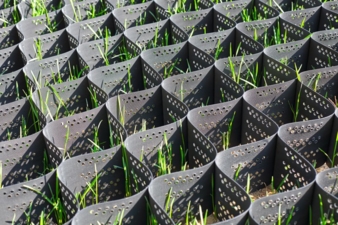30.04.24 – Polypropylene geotextile market
Engineering solutions for construction and landscaping
The polypropylene geotextile market plays a pivotal role in the construction and civil engineering sectors, providing essential materials for soil stabilization, erosion control, drainage management, and environmental protection. With the increasing focus on sustainable infrastructure development, infrastructure resilience, and environmental conservation, the polypropylene geotextile market experiences robust growth and innovation, driven by its versatility, durability, and cost-effectiveness, according to a report published by Persistence Market Research.
Market Growth Factors
Several key factors contribute to the growth and dynamics of the polypropylene geotextile market:
• Infrastructure development and construction activities: The global emphasis on infrastructure development, urbanization, and transportation projects fuels market demand for polypropylene geotextiles. Geotextiles play a critical role in various construction applications, including road and pavement construction, embankment stabilization, retaining wall reinforcement, and erosion control along waterways. As governments and private developers invest in infrastructure upgrades and public works projects, the demand for geotextile solutions to improve soil performance, enhance structural stability, and extend the service life of civil engineering projects increases.
• Erosion control and slope stabilization: Polypropylene geotextiles are widely used in erosion control and slope stabilization applications to prevent soil erosion, manage stormwater runoff, and protect vulnerable terrain from environmental degradation. Geotextile erosion control mats, blankets, and geogrids provide effective erosion control solutions for slopes, shorelines, and vegetated surfaces, reducing soil loss, promoting vegetation growth, and restoring ecological balance in sensitive ecosystems. As climate change intensifies extreme weather events and environmental challenges, the need for erosion control measures and sustainable land management practices grows, driving market demand for geotextile solutions.
• Water management and drainage solutions: The adoption of polypropylene geotextiles in water management and drainage systems contributes to market growth, particularly in urban and coastal areas prone to flooding, waterlogging, and soil instability. Geotextile fabrics serve as filtration and separation layers in drainage systems, subsurface drainage trenches, and stormwater management facilities, allowing for efficient water infiltration, groundwater recharge, and pollutant removal. Geotextile-based drainage solutions help alleviate urban flooding, reduce infrastructure damage, and improve water quality, making them essential components of sustainable urban planning and flood resilience strategies.
• Environmental regulations and sustainability Initiatives: Stringent environmental regulations, sustainability standards, and green building initiatives drive market demand for polypropylene geotextiles as environmentally friendly and cost-effective alternatives to traditional construction materials. Geotextiles enable sustainable construction practices by minimizing soil disturbance, reducing the need for heavy equipment and aggregates, and promoting natural soil stabilization methods. Additionally, the recyclability and longevity of polypropylene geotextiles contribute to their eco-friendly credentials, aligning with circular economy principles and sustainable development goals.
Reinforcing infrastructure for sustainable development
The polypropylene geotextile market is growing due to increased demand in civil engineering, construction and environmental sectors. Known for their strength and durability, polypropylene geotextiles play a key role in soil reinforcement, erosion control and filtration in infrastructure projects. As sustainability gains traction globally, manufacturers have ample opportunity to innovate. There is a growing demand for geotextiles that offer cost-effective and environmentally friendly solutions. In addition, advances in technology are enabling the development of next-generation geotextiles that address diverse engineering challenges. This promotes growth, competiveness and environmental responsibility in the market.
Innovation and customisaton shape the future
Two key trends are emerging in the polypropylene market: the demand for high performance solutions in infrastructure and their increasing role in environmental protection. Manufacturers are innovating to improve durability and address environmental concerns. However, challenges such as quality control and pricing remain, requiring compliance and differentiation strategies. Recent developments focus on sustainability and customisation, with investments in biodegradable options and bespoke solutions. Companies are also offering value-added services to increase customer satisfaction. Amidst competition, the market is evolving to meet diverse needs, emphasising innovation, sustainablility and customer-centric approaches for continued growth and relevance.

